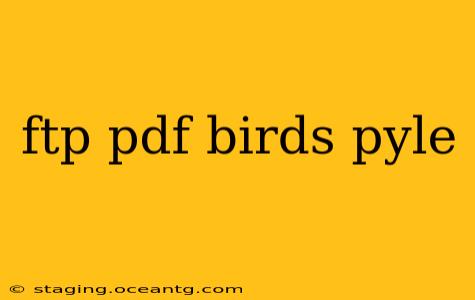A Comprehensive Guide to Pyle's "FTP PDF Birds"
Finding Pyle's "FTP PDF Birds" online requires a nuanced understanding of the search terms and the context of the query. The phrase itself is ambiguous, hinting at a potential misunderstanding or misremembering of the actual resource. Let's break down the components and explore possible interpretations.
Understanding the Search Terms:
- FTP: File Transfer Protocol. This is a networking protocol used to transfer computer files between a client and a server over a TCP-based network. It's unlikely that a bird identification guide would be exclusively distributed via FTP.
- PDF: Portable Document Format. This is a common file format for documents, making it a likely format for a bird identification guide.
- Birds: This indicates the subject matter – avian species.
- Pyle: This is likely referring to a specific author or publisher related to ornithology. There are several authors who write extensively about birds. Pinpointing the exact reference requires more information.
Possible Interpretations and Solutions:
Since the search phrase "FTP PDF Birds Pyle" is imprecise, we need to explore various scenarios:
1. Misremembered Author or Title
It's possible that "Pyle" is a misremembered name, or the title isn't precisely recalled. To find the resource, we need to consider:
- Similar-sounding names: Are there ornithologists with similar names to Pyle? Searching for "bird identification guide PDF" along with alternative spellings or similar names might yield results.
- Partial titles: Do you remember any part of the book's title beyond "Birds"? Including keywords like "guide," "identification," "field guide," or specific bird families (e.g., "warblers," "raptors") can significantly improve search results.
2. Outdated Distribution Method
While FTP is less common for distributing documents now, it's possible an older resource might still use it. However, it's more likely the information was misremembered. Searching directly through online databases of ornithological publications is recommended.
3. Incorrect Term Usage
The use of "FTP" might be a misunderstanding. Perhaps the document was downloaded from a website, and the user mistakenly recalls it being accessed via FTP.
How to Find the Intended Bird Guide:
Here's a structured approach to locating the book:
-
Refine your search terms: Use more specific keywords related to birds, including the region (e.g., "North American birds," "European birds"), specific bird species, or the type of guide (e.g., "field guide," "identification guide").
-
Search major online bookstores: Check sites like Amazon, Barnes & Noble, or specialist ornithological retailers. Use a combination of the author's name (if known) and relevant keywords.
-
Explore online ornithological databases: Many academic institutions and ornithological societies maintain databases of bird-related publications. Searching these databases might reveal the book.
-
Use Google Scholar: This search engine focuses on academic literature, potentially revealing research papers or articles referencing the book you are searching for.
By systematically refining the search terms and exploring different avenues, you're more likely to find the bird identification guide you are looking for. Remember, providing additional details about the book, such as the region it covers or any specific bird species it features, will significantly improve your chances of success.
